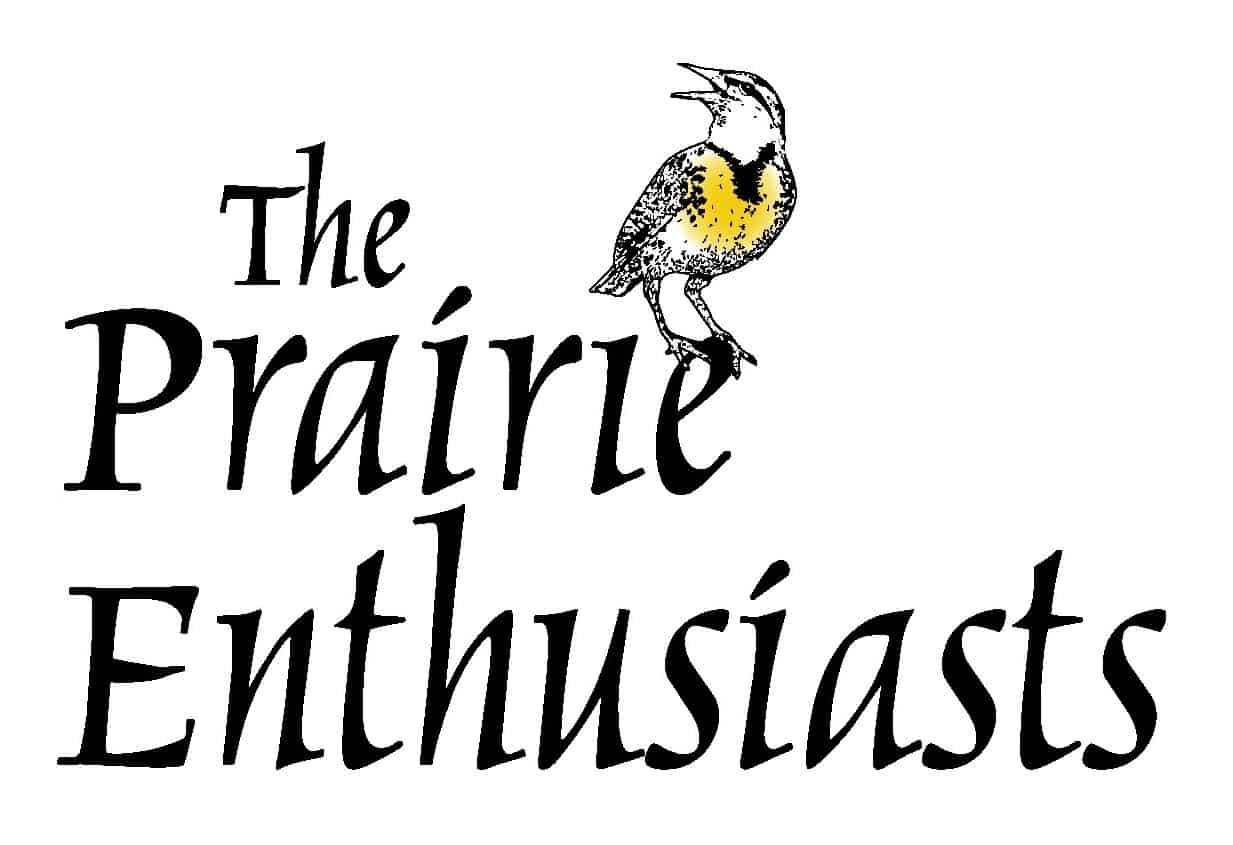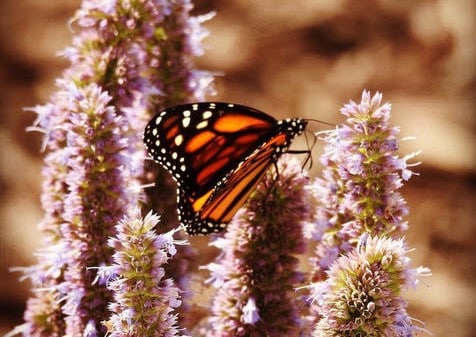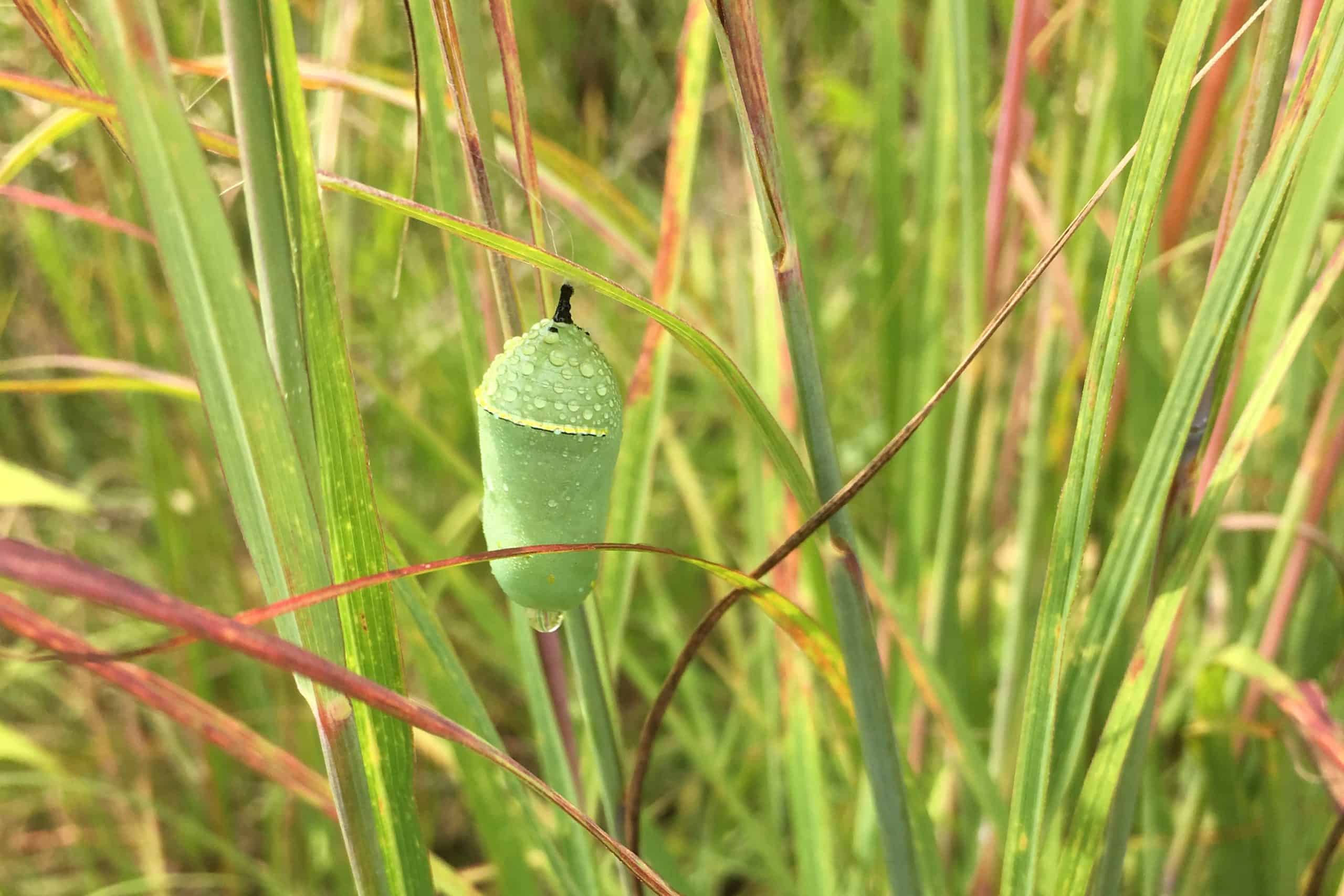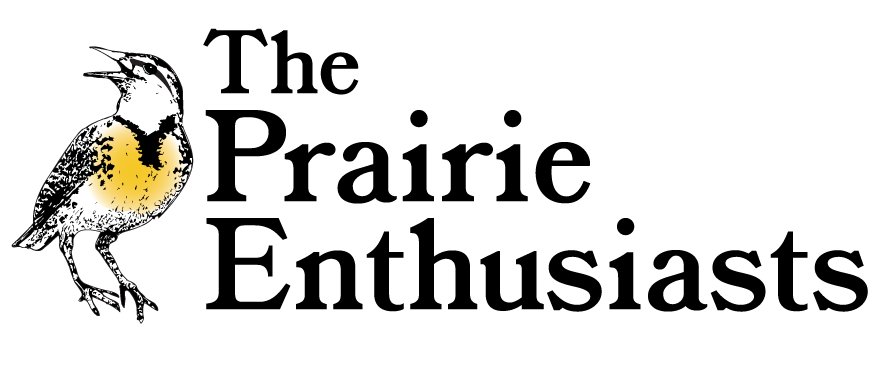
by The Prairie Enthusiasts | Aug 5, 2020 | Inspiration
Updated 12/5/2024
In the heart of Driftless Wisconsin lies Viroqua, home to the Prairie Enthusiasts Chapter Support office. We are lucky to be surrounded by many prairie remnants, State Natural Areas (like Romance Prairie), and several public native gardens within walking distance of the office. One consists of a planted prairie and small oak savanna between two schools.
This outdoor classroom is an urban oasis for bees, butterflies, and birds. What was once an asphalt playground has been transformed into a native plant “Greenspace.” The Prairie Enthusiasts staff have led field trips for students there and assisted with the management plan. As you will see, the native plants are a wonder to behold.

Sign greeting visitors to the PRWS Greenspace. Photo by Joe Rising
From the Pleasant Ridge Waldorf School website:
“In 2012, Pleasant Ridge Waldorf School (PRWS) was able to begin the Greenspace Permaculture Garden in the area between PRWS and the Landmark Center. This had been the former roadway (East Ave) and was an asphalt playground area between the two schools. It was prone to flooding during the spring thaw and generally had limited aesthetics for our school grounds. The focus of this project was twofold: 1) to provide another outdoor classroom area for the children that would incorporate our native habitats of the Driftless Area as well as edible landscaping using Permaculture design, and 2) to enhance the aesthetic of this school and public area between the neighborhoods surrounding our school while improving the infiltration and drainage of water on the site.”
Mark Shepard, a permaculture expert and designer of the PRWS garden, said he “used two different seed mixes both sold as blends by Prairie Moon Nursery [in Minnesota]. The majority was the PDQ mix and in the ‘rain garden’ corner it was their wet prairie blend. I haven’t seen a whole lot of wetland associated species… I especially wanted the Joe-Pye weed to flourish because I have fond memories of it as a lil’ tyke.”
Learn more about the School’s nature programs and outdoor classrooms here.
Thanks to Chris Larson for helping assemble this photo gallery. She has a great eye for natural beauty.

Construction begins. Photo by Cynthia Olmstead

The completed Greenspace. Photo by Joe Rising

Joe Rising and his daughter help plant the prairie. Photo by Cynthia Olmstead

The Prairie Enthusiasts staff lead a prairie plant tour. Photo by Kay Fandel

Chris Kirkpatrick, former Executive Director for The Prairie Enthusiasts, identifies native plants. Photo by Kay Fandel

Black-eyed Susan (Rudbeckia hirta). Photo by Joe Rising

Many compass plants (Silphium laciniatum) have sprung up. Photo by Chris Larson

A summer bouquet: rough blazing-star (Liatris aspera) and purple coneflower (Echinacea purpurea).
Photo by Joe Rising

Partridge pea (Chamaecrista fasciculata). Photo by Joe Rising

White wild indigo (Baptisia alba). Photo by Chris Larson

The beauty of native habitat. Photo by Cynthia Olmstead

by The Prairie Enthusiasts | Sep 4, 2019 | Inspiration
This past winter the monarch butterfly populations overwintering in northern Mexico increased significantly for the first time in recent years. The butterflies used over 6 hectares of land at their winter roosting sites. This is significant, as the goal of the Mid-American Monarch Conservation Strategy is to increase the average to around 6 hectares of use each year. A one year increase does not significantly increase the overall average. Implementing the conservation strategy to increase milkweed populations by billions of stems over the next decades is the single biggest driver to help sustain the monarch populations. Hopefully this strategy will keep the monarch butterfly from becoming listed under the Endangered Species Act.
 In 2014 the US Fish & Wildlife Service (US FWS) was petitioned to consider listing the monarch as an endangered species. The US FWS was supposed to make their listing decision by this past June 2019. The listing decision has now been delayed until December 2020. You can read more about this decision here: The decision primarily seeks to obtain another over-winter measurement of how many hectares the butterflies use to include in its listing decision.
In 2014 the US Fish & Wildlife Service (US FWS) was petitioned to consider listing the monarch as an endangered species. The US FWS was supposed to make their listing decision by this past June 2019. The listing decision has now been delayed until December 2020. You can read more about this decision here: The decision primarily seeks to obtain another over-winter measurement of how many hectares the butterflies use to include in its listing decision.
Since 2017, The Prairie Enthusiasts members, chapters, and conservation partners have collected over 120 pounds of milkweed seed. The seed is being used in restoration efforts to enhance prairie plantings throughout the Upper Midwest, and directly implementing the conservation strategy to increase monarch populations in the years ahead.
Now that we have another season of milkweed seed to collect, it is crucial to keep this program going. Implementing the monarch conservation strategy by planting milkweed seed is the single most important activity that we can do while waiting on an endangered species listing decision by the end of 2020.
The Prairie Enthusiast’s Milkweed to Monarchs ‘19 gives members and volunteers a Grassroots Conservation in Action approach to monarch recovery efforts. This is something practical that every one of us can do this is year, and every year, to contribute towards monarch butterfly sustainability.
All you need to do is collect your milkweed seeds this fall and share it with The Prairie Enthusiasts to helping plant more habitat for monarchs through its chapters, landowners and local conservation partners.
 Here is what we need you to do:
Here is what we need you to do:
- Collect milkweed seed pods by species & note where you collected the seed from. This is best done in September when the pods are green but have started to split open, making the seed easier to clean.
- Process the seed to remove the pod & husk and collect the cleaned milkweed seed. This is also easiest done this month as the seed can easily be removed from the rest of the plant by hand. Watch Bill Cater of Prairie Moon Nursery to see how this is done. There are also some mechanical means of cleaning the seed, See the seed processor.
- Mail (or drop off) your seed to The Prairie Enthusiasts’ office. If you decide to collect significant amounts of milkweed pods weighting dozens of pounds, please contact us to discuss coordinating cleaning of seed in bulk together.
Any interested members, volunteers, or groups interested in picking and cleaning milkweed seed can contact Chris Kirkpatrick, Executive Director at 608-638-1873 or executivedirector@theprairieenthusiasts.org. Seed can be delivered in person or by mail to The Prairie Enthusiasts’ office at: 110 S. Main St., PO Box 824, Viroqua, WI 54665.
Pictures by: Becky Wolter, Brad Keith, and Lydia Martin

by The Prairie Enthusiasts | Jul 31, 2019 | Inspiration
This introduction to the concept of resilience and how it applies to our prairie restoration work was an article published in the August 2019 Prairie Promoter.
Those of us who were at this year’s TPE conference in Menomonie were introduced to resilience during the keynote address. As a review, resilience is simply the ease at which a disturbance can move a system from one state to another. For us prairie enthusiasts looking to apply these concepts to prairie management, disturbances might be such things as fires or intense woody species removal through herbicide use or grazing by goats. General states might include functioning prairies/savannas, degraded prairies/savannas, and reconstructed prairies, fallow fields or cropland.
As most of us know all too well, shifting from some of these states to another can be difficult, and thus, those states are considered resilient. Note that resilience is not a judgment on quality, but rather just the ability to be changed from one state to another. Also, the shift from one state to another can be rapid (such as plowing a prairie to convert to cropland) or slow (such as absence of disturbance leads to a degraded prairie.) Furthermore, a state can change somewhat without moving to a new state.
Let’s apply the principles of resilience to restoring degraded prairies/savannas. Unfortunately, degraded systems are often resilient! The degraded state of a prairie/savanna could be a result of changes in fire frequency, grazing (too much or too little), climate or other drivers, or combinations of these. Reversing one or more of these drivers does NOT rapidly convert a degraded remnant back to a fully functioning remnant.
Degraded systems usually become degraded through a slow process, and one might expect a shift back to a functioning prairie/savanna state might also be a slow process. A degraded prairie is often degraded because of invading woody species. Using the example of prescribed burning as the disturbance, a fire will not rapidly kill all the woody growth and cause a shift from a degraded state back to a functioning prairie/savanna. In fact, short-term effects of reintroduction of fire might have some undesirable effects such as increased number of stems of clonal species and re-sprouts from most species.
We find similar slow results when applying a quick removal of woody species using herbicides or grazing on a degraded site. The rapid removal of the canopy results in invasions by some opportunistic species. We know these species all too well – sunflowers, brambles and short-lived species. It may take decades for these species to come back into some kind of balance with less aggressive species. Even removed shrubs and trees can return either through resprouting or from a well-established seed bank.
The stability of a state can be influenced by non-native species. These species don’t play by the rules that were established as our prairie/savanna ecosystems were evolving, as insect and disease controls for these species are absent in their new environment. Non-natives therefore have an advantage when invading areas with disturbance. The fact that the invasive non-natives have become so ubiquitous across the landscape further makes a degraded system more resilient and our quality remnants less resilient.
Another consideration at the landscape scale is fragmentation. Fragmentation, the isolation of similar natural communities, can’t be ignored when considering the state of individual remnants. In terms of resilience, the isolation may have altered the state through the loss of healthy genetics or complete loss of some species. This idea leads to our cautious use of disturbance during management that may result in species loss that can’t be undone easily given the lack of proximity of sources for the species potentially lost. Our remnants are less resilient due to this fragmentation.
So where does all of this leave us when considering the effects of management on degraded prairies? Prairie restorationists are probably more patient than the average person, but our expectations are probably still too high. Some might consider the solution to be a heavy dose of frequent fire, herbicides or grazing. However, quick results are unlikely given the resilience of degraded systems, and things may get worse before we finally shift a degraded system back to the state of a functioning prairie/savanna.
Hopefully the rudimentary discussion on resilience provided here serves to keep our minds open to this topic when considering our management practices. Be patient and expect frustrations as we undertake the challenge of altering an undesirable resilient state to a healthy prairie or savanna.















 In 2014 the US Fish & Wildlife Service (US FWS) was petitioned to consider listing the monarch as an endangered species. The US FWS was supposed to make their listing decision by this past June 2019. The listing decision has now been delayed until December 2020. You can read more about this decision
In 2014 the US Fish & Wildlife Service (US FWS) was petitioned to consider listing the monarch as an endangered species. The US FWS was supposed to make their listing decision by this past June 2019. The listing decision has now been delayed until December 2020. You can read more about this decision  Here is what we need you to do:
Here is what we need you to do: